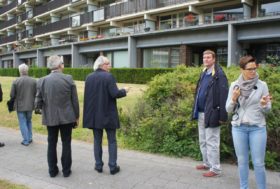 7 July 2014 – This weekend I have shown a number of housing projects to guests from Bremen. They were doing a study trip which was organized by the Senatbaudirektorin für Umwelt, Bau und Verkehr and representatives of the School of Architecture, the Architektenkammer and the BDA. The group was diverse en consisted of designers, project developers, contractors, representatives of social housing trusts and urbanists. My clients from GEWOBA were also there. They explained to me that this study trip is a yearly event and that it is meant to generate a collective set of references and to maintain personal relations within the city. I found that remarkable as such. Apparently, there exists something like a culture of building and dwelling in Bremen which is broadly supported and nourished.
7 July 2014 – This weekend I have shown a number of housing projects to guests from Bremen. They were doing a study trip which was organized by the Senatbaudirektorin für Umwelt, Bau und Verkehr and representatives of the School of Architecture, the Architektenkammer and the BDA. The group was diverse en consisted of designers, project developers, contractors, representatives of social housing trusts and urbanists. My clients from GEWOBA were also there. They explained to me that this study trip is a yearly event and that it is meant to generate a collective set of references and to maintain personal relations within the city. I found that remarkable as such. Apparently, there exists something like a culture of building and dwelling in Bremen which is broadly supported and nourished.
There was something else that struck me: this company left the international set of icons for what it was. Although they spent their nights in MVRDV and OMA designed hotels, their itinery consisted of social housing [the court housing in Ypenburg], urban renewal [Hessenberg] and the renovation of the splayed apartment blocks in Ommoord. The group conveyed inquisitiveness to the way such large-scale investment programmes once were organised in the Netherlands. They were impressed by the expertise of clients, designers and builders which manifested itself before the crisis hit. The ability to deal with large programmes and volume building is a hot topic in Germany nowadays. There is an enormous construction task. The city of Bremen envisages a large scale densification operation and wants to approach that with élan.
Elan. That was a word we never used when we shaped these large-scale investment programmes. Who regards Vinex nowadays as a heroic achievement? If these large investment programmes ever resulted in a culture of building and dwelling, it is becoming clearer and clearer now that its support was limited. Now the production machine is coming to a standstill, we are busy to define the relations between the expertise of designers, builders and clients anew. At best, we have witnessed a temporary consensus. Our culture of building and dwelling was not that stabile. Designers, builders and clients did not travel together.
Hearing my guests from Bremen, I can just conclude that it would be a pity to throw away Dutch expertise of dealing with large-scale investment programmes. At any rate, my long experience with urban renewal tasks appears as a considerable value in my renovation project for Neue Vahr. It would be great if this project ‘from elsewhere’ could be a small contribution to a sustainable local culture of building and dwelling.